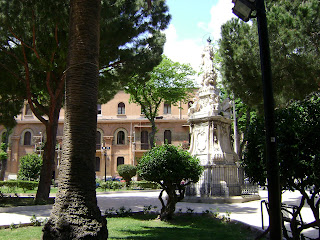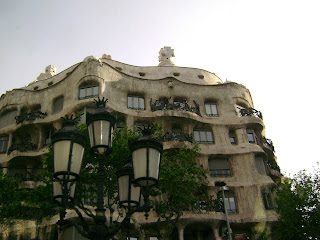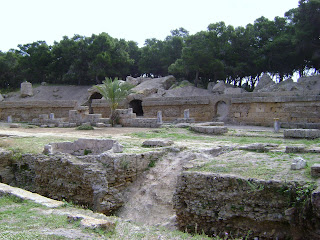

I confess that San Gennaro was not one of the saints that I best knew as a child who enjoyed books such as Butler's 'Lives of the Saints'. Given the fact that he is the Patron Saint of Napoli, one of the most important cities of Italia, I am rather ashamed that I knew little more about him than his name.
When I lived in Manhattan, I discovered San Gennaro to be the focus of one of the most important annual celebrations in the city. The Feast of San Gennaro this year in New York will begin on 11 September and culminate on the actual official Feast Day on 19 September.
I have attended the Feast of San Gennaro in Little Italy more than once, but it always has been a festival that I experienced en passant, when I visited the area of Mulberry Street for some reason and found myself in the midst of the festivities.
It was only when I visited Pompeii that I became aware of the supreme importance of San Gennaro to the people of Naples. Ordinarily, I do not like to be 'guided' through any area, but the guide for Pompeii was charming, erudite and extremely thoughtful. His obvious enthusiasm for his city's Patron Saint gave me a greater understanding of the reason why his Feast is celebrated annually on another continent thousands of miles away.
The miracle of the liquefaction of San Gennaro's blood each year defies scientific reduction. It has occurred now for over a millenium not once, but twice each year, on the first Sunday in May and on 19 September. The first Sunday in May marks the date when his relics were removed from the catacombs of Naples. 19 September is the anniversary of his actual martyrdom.
San Gennaro was a bishop of Benevento who was martyred in 305 during the reign of Emperor Diocletian. Originally named Januarius, he is believed to have been a patrician, a descendant of the Caudini tribe of the Samnites. His martyrdom may have been prompted by his visit to a local prison to console other Christians who were awaiting their own impending deaths. In the fashion of many martyrs of the period, the tale of San Gennaro involves multiple tortures and unsuccessful attempts to end his life by various means. He was thrown first into a furnace where the flames did not touch him. He then was sent into the Flavian Amphitheatre in Pozzuoli to be torn to pieces by wild bears. The bears refused to attack. He was beheaded ultimately at Solfatara and an old man gathered his remains, including his severed head, in a cloth. A woman of Naples named Eusebia soaked up the precious blood of the martyr with a sponge and placed it in a vial.
The relics of this martyr were moved many times and indeed, head and body resided at different locations often throughout history. In 1506, an elaborate Succorpo was completed at the order of a local Cardinal and San Gennaro's remains rest in the Cathedral of Naples.
The blood of the saint is preserved in two phials and the head of the martyr reposes in a silver reliquary. On the first Sunday in May, these are borne in procession through the streets of Napoli from the Duomo or Cathedral to the Franciscan Church of St. Clare. It is here that the miraculous liquefaction occurs.
On the 19th of September, liquefaction occurs once again and the relics are displayed to the public in the Cathedral. What is undisputed fact is that the blood is a solid mass as one would imagine any blood that survived two thousand years would be, and yet somehow it is 'renewed', becoming liquid twice yearly.
The relationship between Vesuvius and San Gennaro is one of faith, as he is the Saint to which the people of the region turn for protection against all calamities, including earthquake and volcanic eruptions. For those who live beneath the shadow of a live volcano, San Gennaro's power is a source of comfort. His intervention is believed to have halted the flow of lava in the last eruption of Vesuvius in the first half of the 20th century.
St. Alphonsus Liguori wrote: 'The Neapolitans honour this saint as the principal patron of their city and nation, and the Lord himself has continued to honour him, by allowing many miracles to be wrought through his intercession, particularly when the frightful eruptions of Mount Vesuvius have threatened the city of Naples with utter destruction.
'While the relics of St. Januarius were being brought in procession towards this terrific volcano, the torrents of lava and liquid fire which it emitted have ceased, or turned their course from the city. But the most stupendous miracle, and that which is greatly celebrated in the church, is the liquefying and boiling up of this blessed martyr's blood whenever the vials are brought in sight of his head. This miracle is renewed many times in the year, in presence of all who desire to witness it; yet some heretics have endeavored to throw a doubt upon its genuineness, by frivolous and incoherent explanations; but on one can deny the effect to be miraculous, unless he be prepared to question the evidence of his senses.'
Miracles are not as popular now with the general public as they once were and yet, our culture's deliberate refusal of faith has not made people more intelligent, more learned or less gullible where deceit and chicanerie are concerned. George Bush's ability to deceive the masses into believing in non-existent 'weapons of mass destruction' in Iraq is proof of that. I find it rather extraordinary that people are reluctant to place their faith in the Divine and yet are quick to surrender their safety and welfare into the hands of political rogues and charlatans.
There are those who are fond of repeating Marx's axiom to the effect that 'religion is the opiate of the masses' but in the 21st century, it is the media that is the true opium of the masses. Whatever abuses have been committed through the ages in the name of different religions have nothing whatsoever to do with spirituality. People believe whatever they are told or shown on a so-called 'news' programme and yet are determined to cast doubt on the existence of 'miracles'.
Like many legends, that of San Gennaro or St. Januarius probably holds echoes of earlier tales and very ancient rites. That by no means invalidates or lessens his importance to the people of Campagna. In fact, it enhances it.
The idea of the blood that is 'reborn' twice yearly has connections in legend with the ancient seasonal death and rebirth of the King or Lord. In fact, during the Roman period, there was a rite that occurred with respect to the grape vats dedicated to Dionysius and a series of seasonal festivals that celebrated the 'rebirth' of the blood of the vine, symbolising the god himself. The first Sunday in May traditionally is the time of May processions honouring new life and fertility. The middle of September is Autumn, a time of harvest.
The motif of the 'three deaths' is one that is found in many ancient legends as well. The fact that St. Januarius first was put through the fire, then subjected to the threat of being torn to pieces by wild animals and finally was beheaded is very much part of an ancient ritual.
In the tale of Mot and Baal from ancient Canaan, the god Mot as a symbol of the grain was subjected to a number of different deaths, ultimately to be reborn. St. Gennaro is part of history but many details of his martyrdom no doubt have been borrowed and enhanced by older tales. The martyrdom of Christians (as well as Pagans) in the arenas of the Roman empire occurred regularly and all the methods described in the Saint's life were common but the motif of a god or hero who can endure more than one 'death' is an integral part of myth.
In the old Norse Eddic tales, the goddess Gullveig was put to death more than once by Odhinn and yet, she survived death by fire again and again. Fire in fact is a symbol both of death and rebirth. The phoenix actually is reborn in the flames.
The Goddess Isis held a child in the fire in order to make him immortal. Demeter did likewise. In fact, 'Achille's heel' is a term that comes from the same ritual, when Achilles as an infant was held in the flames to render him invulnerable. The only part of his body that remained vulnerable was the heel, as that was how he had been held. There are tales in the Bible that stem from the same magical tradition.
It is possible, therefore, that the inclusion of an ordeal by fire in the tale of St. Gennaro is a means by which his 'hero-status' is emphasised.


















